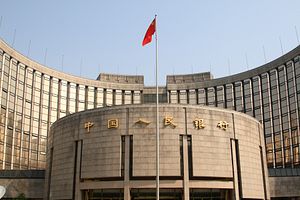Zhou Xiaochuan, governor of the People’s Bank of China, said Tuesday that deposit rate liberalization will be carried out in the next one to two years. This is a critical change in the financial infrastructure since it will allow banks to offer higher interest rates to attract funds that have recently been going into the riskier shadow banking system, in search of higher yields. This institutional change is something that has been long in the making and that will improve China’s turn toward a more market-oriented financial economy.
There are several implications of this expected move. First, it will likely reduce participation in the shadow banking (or non-bank loan financial) sector, which has generated unforeseen risks, since individuals seeking a higher yield have been forced to purchase assets in riskier ventures. Second, it will allow interest rates to be more closely related to market forces and will better reflect the forces of demand and supply for credit. This will likely enhance pricing in the bond market, as market-oriented bank interest rates feed into SHIBOR, the benchmark interest rate given by banks, allowing the bond market to further develop. As a result, reduced segmentation in the bond market may arise. Third, and associated with the second point, the move may in the long run allow the central bank to make greater use of interest rate targeting as a monetary policy tool, rather than using the more costly methods it currently focuses on, such as open market operations and setting the reserve requirement ratio. As interest rates better reflect the demand for and supply of money, they can be used to control liquidity.
There are some barriers, however, to the marketization of interest rates, including the ongoing intervention of state banks in allocation of funds to larger and state owned enterprises. This process interrupts the market forces that should play a role in allocating funds to the demand side of the loanable funds market, as fund placement does not reflect willingness to pay but rather government policy. State intervention in the banks also creates moral hazard, as bad loans that are extended to state-owned institutions are automatically bailed out, preventing non-performing loans from having a negative impact on interest rates which should otherwise reflect tighter liquidity.
The move to free up the deposit rate ceiling is a critical institutional change that will have an overall positive impact on China’s banking sector, although further changes are necessary to promote the reliance on market forces. While some analysts have predicted that liberalizing interest rates in China may lead to financial crisis, we believe this is a seriously flawed view. These analysts compare interest rate liberalization in China to liberalization in the Nordic countries in the early nineties (for example), which did eventually lead to financial crisis in that region. But the reason a crisis arose in that region (and in others, including Southeast Asia) was because at the same time the banking sector was liberalized, foreign financial flows were suddenly allowed to enter these countries. As quickly as the financial flows entered, they later exited these markets, resulting in economic collapse. China has not made any such attempt to open up to foreign financial flows, and has careful control over its capital account that will prevent this case from arising.
This does nevertheless raise a key point. If China should seek to open up its capital account further, it will need to have its own financial markets to control for risk. Only when domestic interest rates truly reflect risk and return on capital should extensive opening of the capital account be considered. This underscores the positive impact that deposit interest rate liberalization will have in China’s financial future, and also highlights the fact that China has some critical changes to make in the efficiency and ownership structure of banks and key enterprises.
On that note, the enhanced efficiency of state-owned enterprises is something that was publicized as a policy objective during the Third Plenary Meeting of the party’s 18th Central Committee last year. This may result in making state-owned enterprises less of a drag on the banking sector and allow a true financial market to take shape. The commitment is encouraging, and is a sign that the leadership is dedicated to the reform process.
When and how all of these factors unravel remains to be seen. Coupled with China’s need to restructure the real economy, these are no small tasks. At this point, China’s pattern of gradual reform seems quite prudent.

































